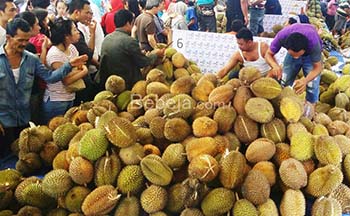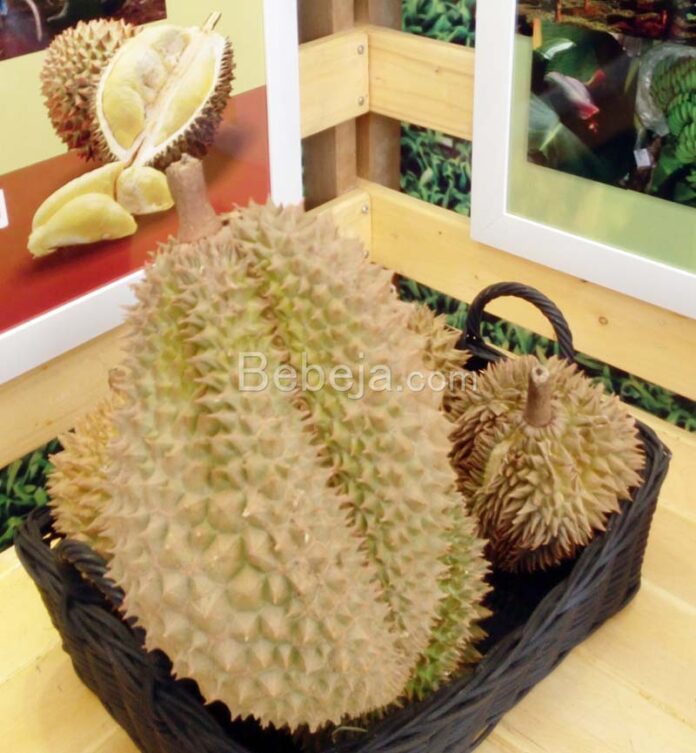Various regions in Indonesia have superior durian species that are favored by the public.
A. Superior Durian from Kalimantan
Kalimantan Island is a paradise for superior durian, with West Kalimantan having the best durian. In Sotok Village, Sekayam District, Sanggau Regency, there is a Copper durian with yellow flesh, thick and soft with a distinctive durian aroma. The seeds of the Bombaceae family members are also small. The productivity of Copper durian trees, which are over 50 years old, can reach 500 fruits per tree per year. Malaysian traders often purchase Copper durian due to its proximity to Entikong, the border of Indonesia and Malaysia.
Additionally, Terong durian is available in Sanggau Regency. This variety of durian is favored by consumers for its sweet, legit, and dry pulp, as well as its attractive golden yellow color. The Terong durian fruit weighs only 1-1.5 kg, despite its trees growing on the riverbanks and having an average age of 100 years. This allows for a tree productivity of over 1,000 fruits.
Sanggau Regency is home to several superior durian varieties, including Raja Mabah durian, Sawah Mas durian, Trenggiling durian, and Aspar durian. Raja Mabah durian is known for its starfruit-like shape. The Sawah Mas durian is characterized by its yellow, soft, sweet, and fragrant flesh. The Aspar durian, on the other hand, is known for its large size and thick flesh. Finally, the Trenggiling durian, despite its small size, is recognized for its thick and exceptionally sweet flesh.
In East Kalimantan, various species of durian are well-known, including Lai Durio kutejensis. The oval-shaped fruit with long, soft spines is a characteristic of Lai. The flesh of the fruit is orange, and sweet, and has a less pungent aroma than durian, making it a suitable choice for consumers who do not enjoy the strong smell of durian. Other popular types of Lai include Lai Kayan, Lai Rencong, Lai Nangka, and Lai Batuah.
B. Superior Durian from Sumatra
Sumatra, particularly North Sumatra, is renowned for its durians. The Belawan durian, with its thick flesh and a legitimate sweet and bitter flavor, is a well-known delicacy. Its aroma is fragrant and slightly gassy. Another popular variety is the 5-Star durian, which is characterized by a red tinge of flesh.
In West Sumatra, the Setapak durian from Pasaman Regency is also highly regarded. The superior durian is characterized by its thick fruit flesh, yellow color, sweetness, and sharp aroma. The texture of the fruit flesh is dry. Other popular types include Belimbing durian and Heart durian. In Solok, Parak Kopi durian is a legend due to its yellow flesh with sweet and fluffy flavors.
In Bangka Belitung Province, delicious durians such as Namlung durian are popularly known as tai babi or chomasi. The durian from Jebus Village in West Bangka Regency is characterized by its round shape and a small notch at the base. The flesh is thick, soft, and yellowish-white in color.
Sutera Manis and Super Copper are two popular types of durian on the island. Sutera Manis has orange flesh with a sweet flavor and a dry, soft texture. Super Copper is almost the size of an adult’s fist, with thick, fluffy, slightly fibrous, and orange flesh that is slightly bitter-sweet. Other superior durians on the island include Kambang, Datuk, Baraapi, and Paristiga.
C. Superior Durian West Java & Banten
Offer a variety of delicious durians. Serang Regency is known for its Copper durian, which is a favorite due to its bright yellow and shiny flesh that is dense. Another popular option is the Ketanjaya durian, which is small, weighing 1-1.5 kg per fruit, and has dry, sticky, legit, and slightly bitter-sweet flesh.
Radio durian is a popular fruit in Pandeglang Regency, having won the Pandeglang Regency Local Featured Fruit Contest in 2010. The durian can weigh up to 3 kg and has thick, buttery yellow flesh. Its flavor is unique, being both sweet and bitter with a soft pulp texture.
In Bogor Regency, West Java, there is the durian Matahari, which has bright yellow to orange flesh and thick fruit. Its flavor is also sweet, and it weighs between 2.75-3.25 kg per fruit. Durian Matahari is a durian variety with stable characteristics that allow it to be grown outside of Bogor. Another variety found in Bogor Regency is Hepe durian, which has smaller seeds and a higher pulp content. It has a slightly sweet and bitter taste with a dense texture.
D. Superior Durian from Central & East Java
Petruk durian from Jepara Regency and Menoreh durian from Kulonprogo Regency are two of the most iconic durians in Central and East Java. Petruk durian is favored for its yellow fleshy, thick, and small seeds with a sweet taste and strong aroma, while Menoreh durian has buttery yellow flesh.
For those who prefer seedless durians, Kakung durian in Sidomulyo Village, Salaman District, Magelang Regency, Central Java is a great option. The seedless durian, known as Kakung by residents, is named after its owner, Amin Hartoyo, who is 72 years old. Durian Kakung has a unique combination of sweet and slightly bitter flavors.
The Banjarnegara Regency is known for its Mimang durian, Kamun durian, and Nimimang durian varieties. Among the three, Kamun durian is considered the most delicious due to its sweet and slightly bitter flavor, and dry yet soft flesh. Mimang and Nimimang durians, on the other hand, are more dominantly sweet. In Langensari Hamlet, Mijen District, Semarang Regency, Central Java, there is a type of durian known as Bagong. It is known for its slightly bitter taste and thick, fiberless flesh.
Banyuwangi Regency in East Java is home to a unique variety of Durio zibethinus with red flesh. This durian was discovered by Eko Mulyanto, a staff member of the Agriculture, Forestry, and Plantation Office of Banyuwangi Regency, and has since been cultivated in multiple sub-districts within the region.
 E. Superior Durian from Papua
E. Superior Durian from Papua
West Papua, offers a unique variety of durian known as the Rainbow Durian. This variety is named for the reddish-orange color of its flesh, which resembles a rainbow. The Pelangi durian is also known for its fleshy, 2 cm thick, and savory texture. Additionally, the tree is highly productive, yielding up to 500 fruits per season. In one year, the tree bears fruit twice and flowers perfectly, allowing for self-pollination.
